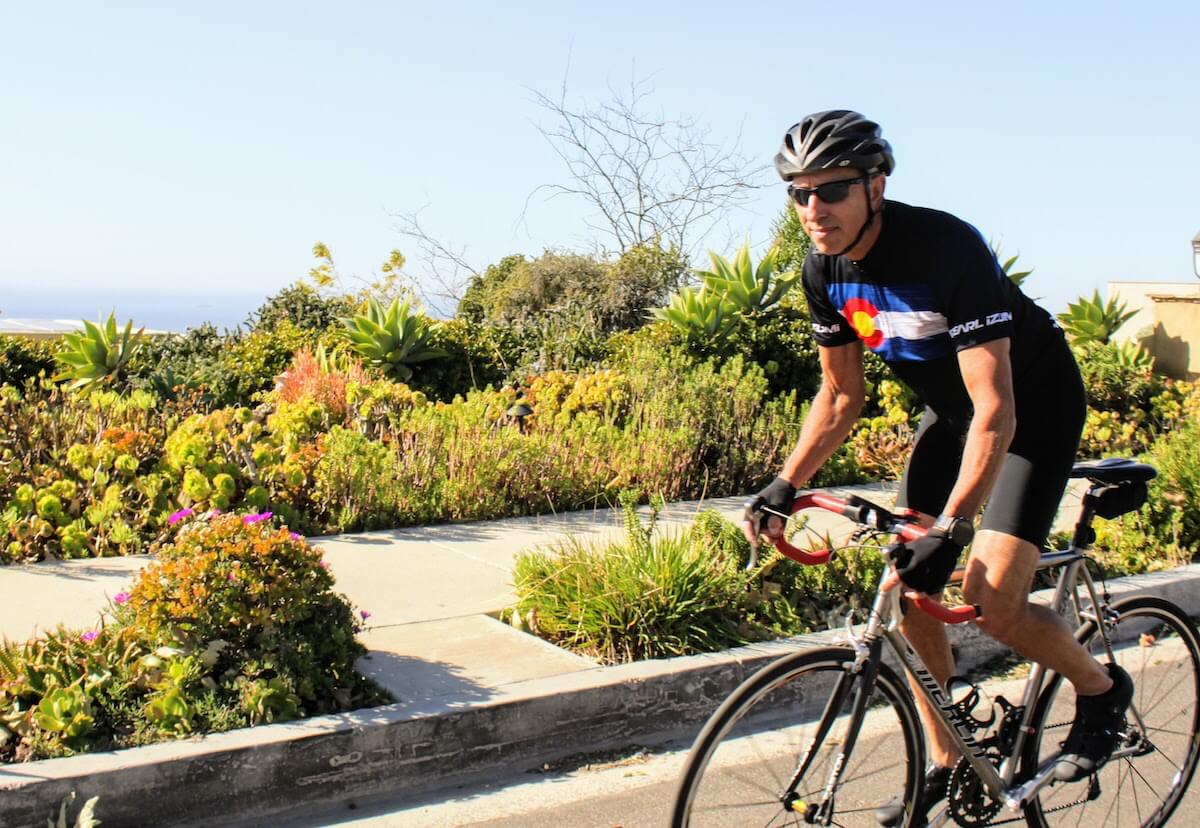
(L-R) Chung Lab graduate students Neil Patel, Aparna Ram, Deborah Chin and Yi Huang, Ride for PKD cyclist Glenn Frommer and Angels 4 Austin’s Emily and Justin Strauss. Image/Akash Sareen
On May 1, 2022, Glenn Frommer dipped the back tire of his bike in the Pacific at Half Moon Bay, California. On September 2, he plans to dip his front tire in the Atlantic on Cape Cod, Massachusetts.
Between these two dots on the map are over 5,300 miles of open road Frommer will cover in his mission to raise awareness and funds for polycystic kidney disease (PKD), which he was diagnosed with in 2015. As his journey wound its way through Los Angeles, Frommer took a detour to the Chung Laboratory at the USC Michelson Center for Convergent Bioscience, where a team of researchers is working toward a cure for this debilitating genetic disorder affecting around 600,000 people in the United States.
PKD causes fluid-filled cysts to grow in the kidneys, which can lead to kidney failure and reduced kidney function. About 50% of those with PKD will have kidney failure by age 60, requiring either dialysis or a kidney transplant. The disorder has two variants: autosomal dominant polycystic kidney disease (ADPKD), the most common form of polycystic kidney disease, usually occurring in adults aged 30-50, and autosomal recessive polycystic kidney disease (ARPKD), which is rarer and can affect the liver and kidneys in newborn babies. There is currently no cure, with research and treatment focused on slowing the rate of the disease and reducing cyst growth.
Frommer said that when his doctor told him that he was diagnosed with an incurable disease requiring a kidney transplant for him to live, he thought “that can’t be the best answer.” He became involved with the PKD Foundation which offers support, education and research funding. As an avid cyclist, who has cycled stages of the Tour de France, Frommer launched the Ride for PKD with the goal of raising at least $500,000 to help fund research and find a cure for PKD.
“We really want to provide a network of support and hope to our community,” Frommer said. “Every day I wake up and I’ve got to get on my bike for another 60 to 80 miles of cycling. I have that arduous task of pushing the pedals and I’m reminded about why — it’s on behalf of our community. It gives me purpose and meaning.”

Glenn Frommer is riding across the United States to raise awareness and funds for PKD research. Image/Ride for PKD
Frommer toured the Chung Laboratory facilities, where researchers are harnessing nanotechnology to target drug delivery direct to the kidneys, in the hope of stopping this disease in its tracks. The research is led by the Dr. Karl Jacob Jr. and Karl Jacob III Early-Career Chair and Associate Professor of Biomedical Engineering, Chemical Engineering and Materials Science, and Medicine Eun Ji Chung and her biomaterials and nanomedicine research group.
Chung said that over the past five years, her team has been focused on designing treatments for PKD using specially engineered nanoparticles that can ferry a payload of drug molecules to the kidney, while limiting its effects on other organs.
“One single hair is 100 micrometers, or about 100,000 nanometers, and a red blood cell is about 10 times smaller than that,” Chung said. “The particles that we’re designing are about 10 to 100 nanometers.”

Frommer visiting the facilities at the Chung Lab. Image/Akash Sareen
“The difference between a drug and a particle is basically the same difference in a soccer ball to the Goodyear Blimp. You can imagine how many soccer balls can fit inside a Goodyear Blimp, and the blimp can then be used as the carrier that can deliver it to a very specific location and that’s what our nanoparticles are effectively doing,” Chung said
Chung said that the particle nanocarriers can fit multiple drugs, and because of their size they can’t access everything in the human body, which allows them to be shuttled directly to the kidneys and not to other areas where they can cause adverse effects.
Chung said the kidney is the main organ in our body that filters blood, with a structure that works like a sieve.
“Our particles fit into this range where they can actually slip through the pores and enter and access the kidneys with really high efficiency,” Chung said. “So that got us into ADPKD. And we thought it was unbelievable that there were no nanomedicine efforts for ADPKD, which affects so many people worldwide.”

Dr. Karl Jacob Jr. and Karl Jacob III Early-Career Chair Eun Ji Chung.
Also visiting the laboratory were Emily and Justin Strauss who lost their son, Austin Davis Strauss, to PKD at 39 days old. The couple founded Angels 4 Austin to provide small comforts and supportive resources for families of premature or sick infants and for those who have been affected by infant loss.
“It was about wanting to turn my pain into purpose,” Emily Strauss said. “Both Glenn’s story and our story are very different, but we have the same intimate attachment to the disease, and really want to advocate for the research.”
Frommer thanked the Chung Lab researchers for their ongoing work into PKD therapies, saying that the nanoparticle drug delivery research offered hope to the patients and families facing this disease.
“Ultimately on behalf of the 600,000 Americans and 12 and a half million people around the world that have this disease, if the work that (the Chung Lab) is doing doesn’t happen, we don’t have hope,” Frommer said. “And we’re looking forward to positive results from collaborations within the lab and with other universities to help advance the science.”
Published on June 2nd, 2022
Last updated on June 2nd, 2022







